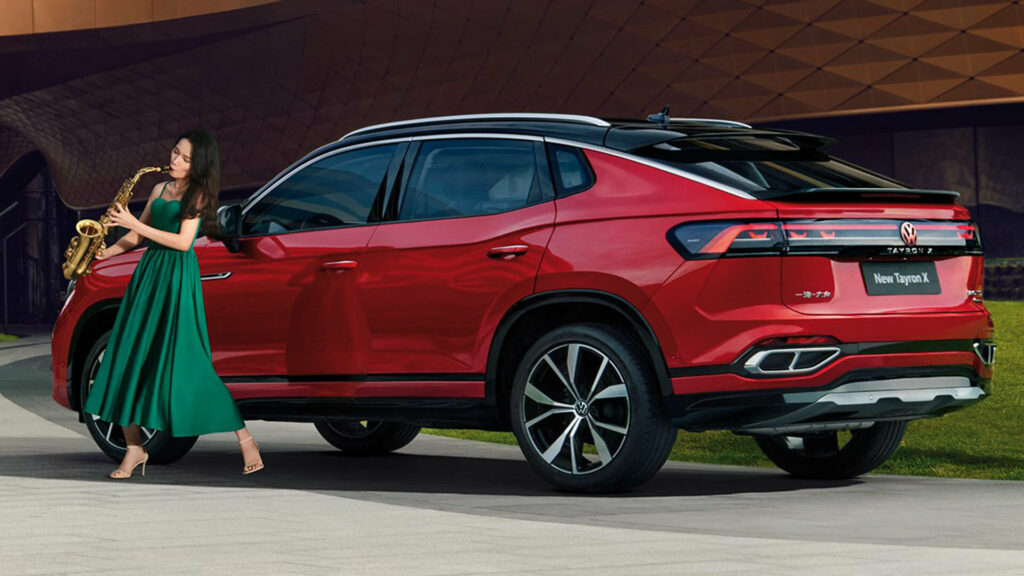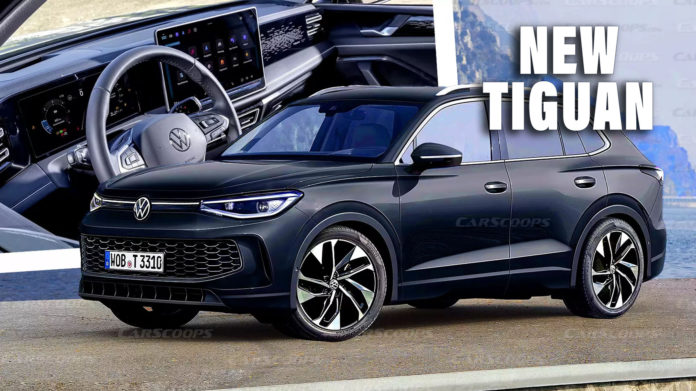This article features independent illustrations that have not been endorsed by VW. We have updated the original story to include all the latest information and photos available. (9/17)
The third generation of the Tiguan SUV is scheduled to make its official world premiere in Europe this month, with Volkswagen’s most recent teaser suggesting a reveal date of September 19. This marks the final internal combustion engine (ICE)-powered compact SUV from the German brand. Interestingly, it appears that North America will not receive this generation of the Tiguan but will instead get a renamed version of the second-generation Tayron that will be introduced in China.
Based on the latest revealing teasers, leaks, and scoops, we have compiled all the relevant information about the new model. It is expected to feature modern styling, larger touchscreen displays, more efficient plug-in hybrid (PHEV) powertrains, and an improved ride.
The current Tiguan was initially introduced in 2014 and underwent a facelift in 2020. However, compared to its newer rivals in the highly competitive compact SUV segment, it has started to feel outdated. Volkswagen aims to address this with an all-new generation, which introduces a departure from the angular surfacing seen in its predecessor, opting instead for a slightly curvier and more sculpted body.
advertisement scroll to continue
More: 2024 VW Golf Spied With Minimum Camo Showing Its Redesigned Face
Illustrations Jean Francois Hubert/SB-Medien for CarScoops
VW has already released official photos of lightly camouflaged, pre-production models, showcasing that the new Tiguan incorporates styling elements from the brand’s fully electric ID range. Our artists have digitally removed the wraps to offer a visual representation of what the final production model will look like. Additionally, we’ve also spotted camo-free, pre-production models on the road.
The redesigned front end has more refined appearance combining evolutionary design cues with references to previous generations. A notable feature is the optional advanced IQ Light HD Matrix technology available for the headlights, accompanied by a full-width LED bar that accentuates the solid grille.
As part of the new design language for ICE-powered VW models, a notable feature is the front bumper with a prominent central intake and vertically-mounted air ducts This design trait will also be adopted by the upcoming facelifted Golf and next-generation Passat Variant. The greenhouse design draws inspiration from the larger Touareg, although the smaller-diameter wheels on the base Tiguan trims do not fully highlight the muscular front and rear fenders. While the plastic cladding around the bodywork remains subtle, it’s worth noting that there are no plastic skid plates as the model was not specifically intended for adventure-focused purposes.
Swoopier design
The rear design of the new Tiguan can be considered more of an evolution rather than a revolution. The LED taillights are now integrated into a single trim piece, and the rear glass maintains its traditional form, avoiding the coupe-SUV trend. The rear bumper retains the distinctive full-width reflector from the outgoing Tiguan.
In terms of dimensions, the new Tiguan measures 4,551 mm (179.2 inches) in length, 1,939 mm (76.3 inches) in width, and 1,640 mm (64.6 inches) in height. It rides on a wheelbase of 2,681 mm (105.5 inches). Compared to the outgoing model, the new Tiguan is 32 mm (1.3 inches) longer and 5 mm (0.2 inches) taller, while maintaining the same width and distance between the axles.
High-tech interior that brings back buttons
Volkswagen says it has placed significant emphasis on the interior of the new Tiguan, which was fully unveiled in pre-production form without any camouflage. The standout feature is the large 15-inch touchscreen infotainment system, sourced from the ID.7, which protrudes from the dashboard in a somewhat prominent manner. Hopefully, the 12.9-inch unit that will be installed in the lower trims, will be more seamlessly integrated into the interior design. Additionally, a smaller digital instrument cluster and a head-up display contribute to the overall digital cockpit experience.
According to the automaker, the designers dedicated significant effort to enhance the intuitiveness of the interface based on customer feedback. Although the climate controls remain integrated within the touchscreen, the addition of illuminated sliders and shortcuts promise to simplify the user experience. Furthermore, the new rotary control on the center console, which includes its own integrated display, adds a physical element to the overall interaction. In response to customer concerns, the steering wheel has been redesigned to eliminate the touch-sensitive controls that were criticized, as previously promised by VW.
More space inside
For added luxury and comfort, optional ergoActive seats are available for the driver and front passenger, featuring heating, ventilation, four-way lumbar support adjustment, and a 10-chamber massage function, akin to the creature comforts found in premium segments. Volkswagen says it also emphasized the use of high-quality materials throughout the interior, along with practical storage solutions integrated into the center console.
The new VW Tiguan will provide a more spacious interior compared to its predecessor. Rear passengers will enjoy an additional 10 mm (0.4 inches) of headroom, while boot capacity has also been increased to 648 liters (22.9 cubic feet), which is 33 liters (1.2 cubic feet) larger than before.
Gasoline, Diesel, Mild-Hybrid, And Plug-In Hybrid Options
The new Tiguan will be based on the upgraded MQB Evo architecture, which is an enhanced version of the platform used by previous ICE-powered models from Volkswagen As a result, the automaker is not planning an EV variant of the Tiguan, since there won’t be much breathing space between the upcoming ID.3-sized electric SUV and the ID.4.
It may not get a pure electric version but the Tiguan will benefit from an enhanced range of electrified options, which will play a more significant role in the lineup. A notable highlight is the introduction of new Plug-In Hybrid (PHEV) powertrains that utilize the updated 1.5 TSI Evo2 engine paired with an undisclosed number of electric motors. These PHEVs, identified by the eHybrid designation, will offer two power outputs: a combined 201 hp (150 kW / 204 PS) and 268 hp (200 kW / 272 PS), with the latter configuration providing all-wheel-drive capabilities. Of particular importance, the larger 18.5 kWh lithium-ion battery now supports DC charging and delivers an extended zero-emission driving range of approximately 100 km (62 miles).
It has been confirmed that the new Tiguan will also be available with petrol (TSI), mild-hybrid petrol (eTSI), and turbodiesel (TDI) powertrains, although VW didn’t go into specifics. Petrol (gasoline) options will most likely include the mildly electrified 1.5-liter eTSI and the 2.0 TSI. As for the trusted 2.0 TDI diesel, this will certainly keep its position in the lineup – at least for a few more years. All powertrains will be exclusively mated to a DSG automatic gearbox which means there will be no manual option for the new Tiguan.
Notably, the performance-focused Tiguan R with the 2.0 TSI producing 315 hp (320 PS / 235 kW) in the outgoing generation wasn’t mentioned in the press release, so we don’t know if it will get a direct successor. The R sub-brand has pledged to go EV-only by 2030, so VW could skip the Tiguan this time and focus on spicing up its ID range instead.
One thing VW highlighted is the optional DCC Pro adaptive suspension which makes its debut in the compact segment. The sophisticated system features two-valve shock absorbers and offers 15 different levels of adjustment covering the entire spectrum between the Comfort and Sport settings.
European Market Launch In Early 2024
Photos MQB-Coding & Retrofit, Volkswagen
As recently reported, the new VW Tiguan is expected to have its official unveiling on September 19, 2023, with European sales anticipated to commence in the first quarter of 2024. According to the latest reports, the longer Tiguan Allspace, which was the only variant offered in the US, will be discontinued.
The Tiguan has ample opportunity to shine until Volkswagen transitions into an EV-only brand in Europe by 2033. Nevertheless, this compact SUV faces formidable competition from strong rivals such as the Renault Austral, Nissan Qashqai, Kia Sportage, Hyundai Tucson, Ford Kuga, and the mechanically-related Skoda Kodiaq, which is also set to introduce a new generation in 2024. It’s worth noting that we did not include the Peugeot 3008, as the Stellantis model is expected to adopt a coupe-SUV stance and go EV-only in the near future.
The U.S. Will Likely Get China’s Tayron And Tayron Coupe Instead

It has been reported that the new Tiguan will not be sold in North America. Instead, the region will receive the second generation of China’s VW Tayron, expected to debut by 2025, serving as the successor to the current Tiguan Allspace. As is the case with the current model, it’s anticipated that there will be both crossover and crossover-coupe variants. There’s speculation that the Tayron will become a global model, sharing its foundations and PHEV powertrains with the EU-spec Tiguan.
Volkswagen officials have revealed that the upcoming Tayron will come with two plug-in hybrid powertrains, featuring gasoline engines, an electric range of more than 62 miles (100 km), and power outputs of either 201 hp (150 kW / 204 PS) or 268 hp (200 kW / 272 PS).
Interestingly, this new global compact crossover will go by different names depending on the market. In the UK, it will retain the Tayron designation, while in some markets, including the US and Canada, it will be introduced as the next Tiguan. These specific markets are likely those where the traditional Tiguan won’t be offered, although additional details are anticipated to emerge in the coming months.

